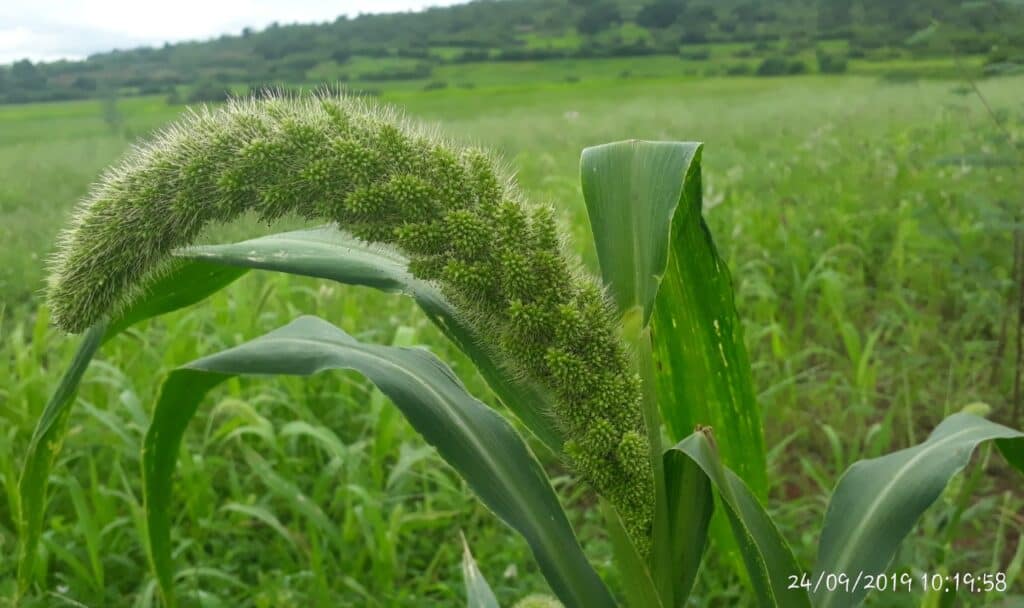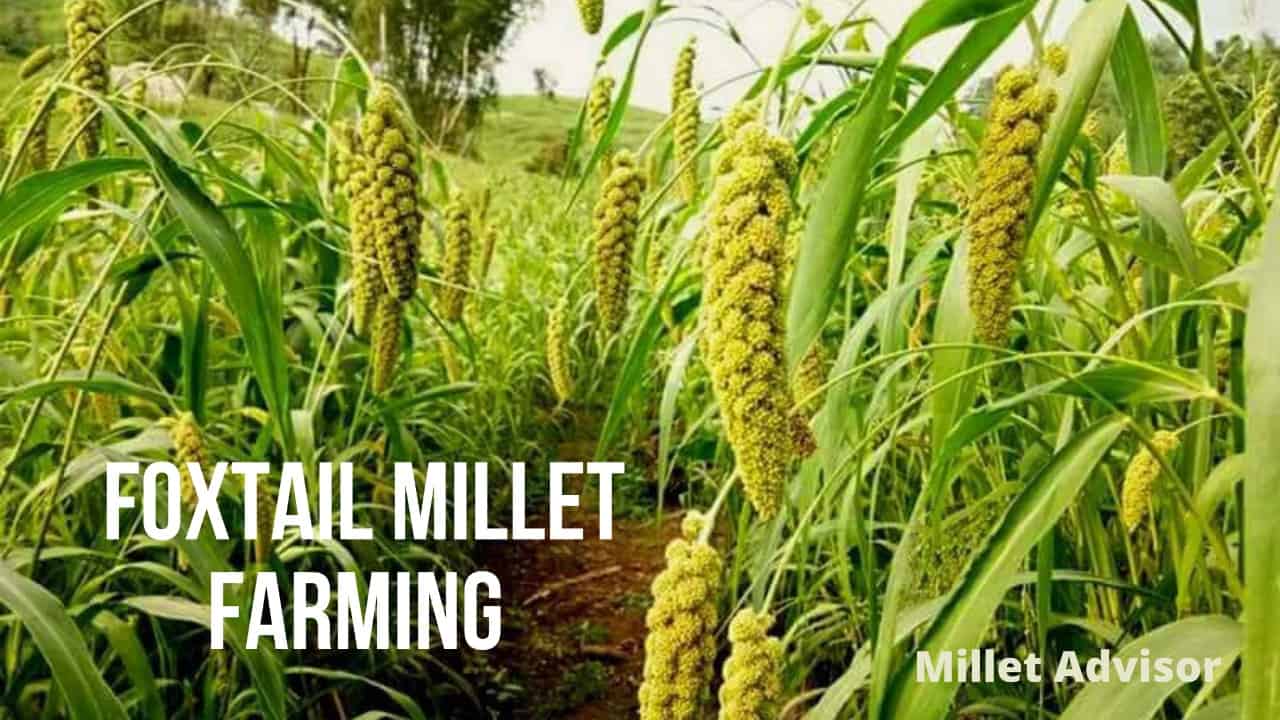Table of Contents
Foxtail Millet Farming – Introduction
Foxtail Millet is one of the oldest the cultivated millets in the world. It is cultivated in about 23 countries in Asia, Africa, and America. The scientific name of Foxtail Millet is Setaria italica. In India, it is mainly cultivated as a rainfed crop. It is a self-pollinating, short-duration, C4 cereal plant. It is good for human consumption, feeds for poultry and cage birds, and fodder for cattle. Foxtail Millet ranks second among the millets production in the world.
In India, Foxtail Millet Farming is carried out in Andhra Pradesh, Tamil Nadu, Karnataka, Telangana, Madhya Pradesh, Maharashtra, Rajasthan, Uttar Pradesh, and to a small extent in the north-east states.
Foxtail Millet Health Benefits:
Foxtail Millet has a low glycemic index and thus recommended for diabetic patients. It releases glucose steadily without affecting the metabolism of the body. It is good for pregnant and lactating women. To know the health benefits of Foxtail Millet in detail – 10 Health Benefits of Foxtail Millet.
Local Names of Foxtail Millet:
| Language | Name |
| Hindi | Kangni, Kakum |
| Tamil | Tenai |
| Telugu | Korra, Korralu |
| Malayalam | Thina |
| Marathi | Kang, Rala |
| Kannada | Navane |
| Gujarati | Kang |
| Odia | Kanghu |
| Bengali | Kaon |
| Punjabi | Kangni |
| Kashmiri | Shol |
Soil and Climate for Foxtail Millet Farming:
Foxtail Millet can be grown in both tropical and temperate climates, with low and moderate rainfall. Even at an altitude of 2000 metres and 500-700 mm of yearly rainfall, the crop may be cultivated. It needs moderately fertile and well-drained soil. They are not tolerant to flooded soils or severe drought.
Foxtail Millet Farming – Varieties in India:
| State | Popular Varieties in the State |
| Andhra Pradesh | SiA 3088, SiA 3156, SiA 3085, SiA 326, Lepakshi, Narasimharaya, Krishnadevaraya, PS 4 |
| Karnataka | DHFt-109-3, HMT 100-1, SiA 3088, SiA 3156, SiA 3085, PS 4, SiA326, Narasimharaya |
| Tamil Nadu | TNAU 43, TNAU-186, Co (Te) 7, Co 1, Co 2, Co 4, Co 5, K2, K3, SiA 3088, SiA 3156, SiA 3085, PS 4 |
| Telangana | SiA 3088, SiA 3156, SiA 3085, SiA 326, Lepakshi |
| Rajasthan | Prathap Kangani 1 (SR 51), SR 1, SR 11, SR 16, SiA 3085, SiA 3156 |
| Uttarakhand | PS 4, PRK 1, Sreelaxmi, SiA 326, SiA 3156, SiA 3085 |
| Uttar Pradesh | PRK 1, PS 4, SiA 3085, SiA 3156, Sreelaxmi, Narasimharaya, S-114, SiA 326 |
| Bihar | RAU-1, SiA 3088, SiA 3156, SiA 3085, PS 4 |

Time of Sowing – Foxtail Millet Farming:
Foxtail millet is generally a rainfed crop but can be grown in the Rabi season where there is a source of irrigation. During Kharif, the seeds are sown in the month of July-August and in Rabi in the month of August to September(Tamil Nadu).
Seed Rate:
- 8-10 kg/ha for Line Sowing
- 15 kg/ha for Broadcasting
Seed Treatment:
Seed treatment is a must to avoid diseases and to protect the young roots from fungus. It can be done organically or by using chemicals. Beejamrut for organic seed treatment and Carbendazim@2g/kg for chemical treatment.
Spacing in Foxtail Millet Farming:
25-30 cm (row to row), 8-10 cm (plant to plant). The seeds should be planted 2-3 cm in depth for proper germination.
Manures and Fertilizers in Foxtail Millet Farming:
It is always recommended to apply fertilizers based on the soil tests of the particular field where foxtail millet farming is to carry out. Apply compost or farmyard manure @5-10 tonnes/hectare about a month before sowing seeds.
Millets require fewer inputs as compared to wheat and rice. Generally to get a good yield 40 kg nitrogen, 20 kg P2O5, and 20 kg K2O per ha. Apply entire P2O5 and K2O and half of the nitrogen as basal dose and remaining half of nitrogen at 30 days after sowing.
Weeding and Intercultural Operations in Foxtail Millet Farming:
Weeds are the major problem in millet cultivation. Two inter cultivations and one hand weeding is line sown crop is recommended. When the crop is 30 days old, an intercultural operation using a tyne-harrow is recommended. Cycle weeder can also be used and it is easy to operate and saves time and energy.

Irrigation:
Foxtail Millet grown in the Kharif season require no or very little irrigation. It is primarily a rainfed crop. However, if the dry weather lasts for a long time, 1-2 irrigations should be applied. Depending on the soil type and weather conditions, a summer crop may require 2-5 irrigations.
Diseases in Foxtail Millet Farming:
1.Blast: It is caused by a fungus known as Pyricularia setariae. Typical spindle-shaped spots on the leaf lamina. Under highly congenial conditions such spots enlarge, coalesce and leaf blades especially from the tip towards the base give a blasted appearance.
Blast can be controlled by spraying Tricyclazole 75 WP @ 0.6 g/litre of water.
At 20-25 days after transplanting, foliar spray with Pseudomonas fluorescence (4g / 1 water), blast diseases can be prevented.
2. Grain Smut: It is caused by Ustilago crameri. Spikelets bigger in size, velvety gall-like structure. It can be controlled by treating the seeds with Carbendazim @2g/kg of seed.
3. Downy Mildew/ Green ear: It is caused by Sclerospora graminicola. Shredding of infected leaves, conversion of spikelets into the leafy structure. Treating the seeds with (Metalaxyl M4 + Mancozeb 64 %) @6g/kg. It can be controlled by roughing out the affected plants.
Pests in Foxtail Millet Farming:
Armyworm, cutworm, and leaf scraping beetle can be serious causes of damage to the crop. Although shoot fly is not a common pest, it can be found in some regions. Shoot fly damages the crop in the seedling stage to a six-week-old crop. As a result of feeding, the central shoot starts drying and shows the typical appearance of a dead heart in the early stage and profuse tillering in the later stage. Damage tillers may produce ear heads, but no grains.
It can be managed by early sowing within 7-10 days of the onset of monsoon. Seed Treatment with Thiamethoxam 70 WS @3g/kg of seed can be used.
Harvesting of Foxtail Millet:
Generally, foxtail millet is ready to harvest in 80-90 days after sowing. The crop is harvested when the ear heads are dry. It can be done by using a sickle by cutting the whole plant or only the earheads. In the Kharif season, the crop is harvested in the month of September to October, while in Rabi in the month of February to March.

Yield of Foxtail Millet:
Under ideal conditions and proper agronomic practices, the grain yield can be 15-18 quintals per hectare.
Author: Tapas Chandra Roy, A Certified Farm Advisor on Millets, ‘Promoting Millets from Farm to Plate’. In a mission to take the forgotten grains- Millets to Millions. To remain updated on my blogs on millets you can join my Telegram Channel – Millet Advisor.


Very good with detail information
Coved all aspects of millet cultivation. Excellent article
I introduce myself as a Consultant Agronomist. I just wanted to know about Kodo & Japanese Millet. If you would kindly let me know the same, I shall remain ever grateful.